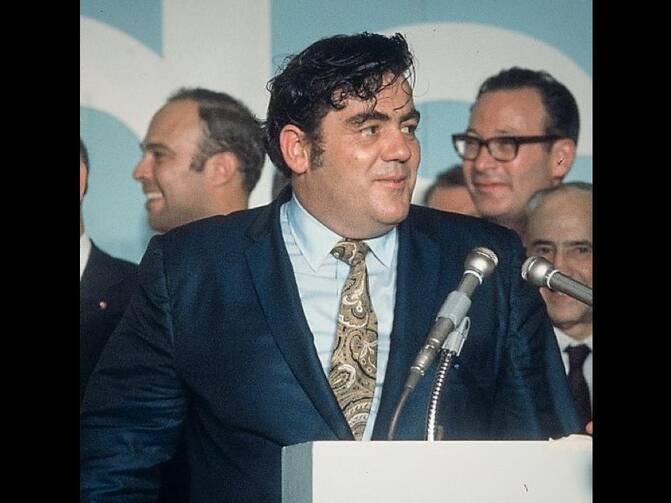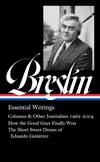Review: An anthology of Jimmy Breslin, chronicler of New York’s best (and worst)
After the death of “The French Connection” director William Friedkin last year, the author Jonathan Mahler recalled that Gene Hackman was reluctantly cast as Popeye Doyle in the film, and only after Jimmy Breslin (among others) was seriously considered for the iconic role.
That’s how big a deal “JB” was in 1970.
A decade earlier, Breslin was just another thirtysomething sportswriter, raising four kids on Long Island. He had managed to publish a book with Doubleday about a late 19th-century racehorse trainer. A fine life. Not exactly Hollywood.
Yet Breslin was on his way to becoming a national figure and would remain one for decades. The Queens native filed news copy from the days of Jackie Robinson through the re--election of Barack Obama and was often in the middle of current events, rather than their mere chronicler.
Some of Breslin’s best work has now been collected in the Library of America’s latest volume, judiciously edited by one of Breslin’s true heirs, The New York Times correspondent Dan Barry. Essential Writings includes dozens of newspaper columns and magazine articles from 1960 to 2004, as well as two complete nonfiction books. Excerpts from Breslin’s uneven but undeniably powerful novels World Without End, Amen (1973) and Table Money (1986) might have rounded out this volume nicely. Overall, though, Barry has curated a collection that is not only a treasure but also a thought-provoking ramble through what Philip Roth called the “American Berserk.”
A journalistic trailblazer in form as well as content, Breslin wrote of many subjects that could broadly be defined as “Catholic,” from the nuns who taught him at St. Benedict Joseph Labre grammar school to the Irish and Italian barflies who waxed philosophic atop Queens barstools, from the overwhelmed staff at St. Vincent’s Hospital in the earliest days of the AIDS crisis to the feckless bishops who enabled decades of child abuse. “One statement reportedly made by Christ,” Breslin wrote in July 2003, “is ‘Woe to those who do harm to children.’” After reciting a now-familiar litany of church leadership failures, Breslin thundered: “Anybody who puts five dollars in a collection basket approves of what they’ve done.”
Indignation became Breslin’s default mode, which—all too often—was entirely appropriate. It is worth adding that the aforementioned column closes with a visit to a church basement auditorium with “110 excited children in a summer Bible study class,” throwing around toy “plagues” of frogs and locusts. It is, Breslin declares, “what the Catholics should be about. One sweet moment after the next. We know it as love.”
In 2004, he wrote a book called The Church That Forgot Christ, filled with sadness and rage, in which the author dubs himself “Bishop Breslin,” adding that he and others “qualify for the rank” because they are not a “pedophile or pimp.” Essential Writings includes two very different books: The Short Sweet Dream of Eduardo Gutierrez (2002), which, if there is any justice, will come to be seen as one of the more prescient books of the early 21st century, and How the Good Guys Won (1975), a peek behind the scenes of the Watergate investigation. The latter makes for a complicated read in Donald Trump’s America.
Breslin is perhaps most famous for his Nov. 26, 1963, dispatch about Clifton Pollard, who “finished breakfast, and left his apartment so he could spend Sunday digging a grave for John Fitzgerald Kennedy.” It is “a classic of its journalistic form,” Barry notes, reorienting how big, emotional news stories could and should be covered. Numerous Breslin trademarks are already fully formed in the Pollard column: an urgent yet unhurried tone, one that is serious but not somber. “Pollard got behind the wheel of a machine called a reverse hoe…which scoops earth toward the operator, not away from it as a crane does,” Breslin writes before adding: “One of the last [people] to serve John Fitzgerald Kennedy, who was the thirty-fifth President of this country, was a working man who earns $3.01 an hour and said it was an honor to dig the grave.”
Reverence for honest, intricate labor, for the daily grind, still imbued Breslin’s writing 40 years later in Short Sweet Dream. He reports from both sides of the U.S.-Mexico border to tell a story that is both a real-life update of Pietro di Donato’s 1930s Italian immigrant saga Christ in Concrete and a prologue to the migration crisis that may eventually define the entire 21st century. Morethan even the Pollard column, this short, explosive book is what should be read right now in journalism classes, as well as by history and political science—and urban planning and law school—professors.
Indeed, it might be tempting to see Breslin’s Essential Writings as some kind of exercise in fedora-clad nostalgia. Even the excellent 2018 documentary “Deadline Artists,” about Breslin and fellow New York City wordsmith Pete Hamill, opened with a soundtrack reminiscent of Glen Miller or Artie Shaw, even if these writers were closer in spirit to Dylan or Springsteen.
But just because such ink-stained giants will never again stalk the earth does not mean Breslin’s work is a mere “eulogy for journalism,” as The Atlantic referred to “Deadline Artists.” The raw material for quality journalism is still very much out there. It is the collection and delivery of this material that is currently (and radically) in flux. Breslin himself understood such challenges—but also the opportunities they present—back in 1981, riffing on a journalist who won a Pulitzer Prize with a heavily fabricated story. “Why she had to make up the story is beyond me. Walk the city streets and you get anything you want; in Brooklyn the other day there was a seven-year-old who took part in a felony homicide.”
Journalists from Patrick Radden Keefe to Adrian Nicole LeBlanc to Dan Barry himself ably carry Breslin’s torch. But so do varied documentarians and bloggers, true-crime sleuths and social media influencers. The New Journalism’s influence is neither dead nor buried. It has merely been democratized, diffused—and, yes, diminished and dumbed down. Many 21st-century journalistic(ish) “narratives” are indeed trashy, melodramatic and preachy, but the Breslins and Tom Wolfes were not above dipping their toes into such waters. They still consistently put readers on the front lines of fierce domestic, international and intellectual wars, with an immediacy that entire reality TV production crews can’t replicate.
An old saw has it that journalism is a first draft of history, as if this were some kind of shortcoming. Much of Essential Writings reads simply like a raw, unpolished chronicle of post-World War II America. “Sure there was brutality last night. Terrible, sickening brutality,” Breslin wrote in the summer of 1964, after yet another clash between cops and African Americans in Harlem. “But this was a mess, an absolute, incredible mess, and if you were on the street with the bottles coming down and who the hell knows what was going to come from these rooftops, there was only one thing to do.”
Breslin himself got clocked a few years later when the up-from-his-bootstraps Irishman, now running for city council president alongside Norman Mailer, was heckled mercilessly at—of all places—Gaelic Park in The Bronx. A tsunami-like backlash was blowing in, and even Breslin would struggle to find the poetry in it.
James Earle Breslin (1928-2017) was born in a stretch of Queens he once described as “sooty.” His father vanished, and not long after, young Jimmy saw his stressed-out mother hold a pistol to her head. The episode was never spoken of—though Breslin did include it in a hand-drawn newspaper he produced as a child. As a working-class public high school graduate (“I went the full five years,” he liked to joke), Breslin used sportswriting as the side door into the world of letters. Essential Writings is assembled chronologically, so the first several readings—long profiles of a jockey, a boxer and Casey Stengel—are not exactly clickbait. Soon, though, we are in a Brooklyn flat with the 77-year-old matriarch of the notorious Gallo family. “Big Mama” Nanziata rants about that “stool pigeon” Joe Valachi, and a punishment she once meted out to her criminal grandson: “Then, I had teeth, [so] I bit him right on the leg.”
Soon Breslin is hawking Piel’s beer on TV, then finds himself at the Audubon Ballroom when Malcolm X is killed. And by 1977, when a serial killer “from the gutters of NYC” wanted to take his terrible crimes public, to whom did he reach out? Say what you will about the ethics of Breslin playing ringmaster during Son of Sam’s bloody circus. But the very same events also took Breslin to a “bedroom in the rear of a second-story apartment on E. Fifth St. in Flatbush” for a restrained portrait of a grieving father.
(In other poignant writings, Breslin himself would mourn the loss of his first wife, as well as two daughters.)
By the late 1970s, of course, something had shifted—in Breslin’s work and the culture. Watergate seemed to confirm that the country—as Breslin’s book title, How The Good Guys Finally Won, suggests—could be divided between “good guys” and “bad.” Another old saw has it that great journalism comforts the afflicted and afflicts the comfortable. That sounds righteous, except that one pundit’s “comfortable” bad guys are another’s “silent majority.” Breslin won his own Pulitzer in 1986 as a fierce critic of police brutality, by which time those Gaelic Park hecklers had become a sizable portion of New York voters who believed that Rudy Giuliani, not JB, spoke for them.
This is one of the many things that makes The Short Sweet Dream of Eduardo Gutierrez so extraordinary. It transcends many (though not all) of the contentious tropes and traps that mar contemporary journalism. Ultimately, Short Sweet Dream is a harrowing portrait of the ties that bind the world, America and New York—a city thick with charlatans and “crooks with blueprints” that the planet’s most desperate just can’t stay away from. That includes Eduardo and his girlfriend—“fifteen and a half years old…working sixty-five hours a week and she thought it was glorious.” And so it goes for the thousands heading north to the border, just as it was for those “dreadful old ships from Magilligan in Northern Ireland, from…Naples and Palermo and Odessa.”
Even one of Breslin’s bad guys in Short Sweet Dream “fled Hungary in 1944,” while another had a father who “pulled burglaries and holdups,” and told prosecutors “he did it because of unemployment” before going to prison, and watching his son—Rudy Giuliani—become kind of a big deal. But Short Sweet Dream is also about C-joists—that is, beams used in building construction “that can be from six to twelve inches wide and an inch and a half thick.” They hold all of New York City together—so long as they’re installed correctly, and treated to resist fire. And as long as they’re not the cheap kind.
Short Sweet Dream hits as hard as Robert Caro’s The Power Broker, and at a fraction of the length. It may turn out to be more enduring than anything else written about 9/11. It may turn out that 9/11 was as much about the factors that sent Eduardo across the border as it was about Allah or Israel.
Some things about Jimmy Breslin may not have aged all that well. But Eduardo Gutierrez and Clifton Pollard, “Big Mama” Nunziata and the Son of Sam are timeless. And there are plenty more out there where they came from. Go walk the city streets and see.
This article also appeared in print, under the headline “Heart of the City,” in the April 2024, issue.











